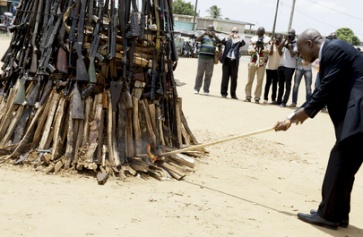On 7 June 2021, we marked the twentieth anniversary of the UN Secretary-General’s first report on the Prevention of Armed Conflict1, and this year also marks the twentieth anniversary of the Firearms Protocol and the UN Programme of Action on small arms and light weapons (PoA) adopted on 31 May 2001 and 20 July 2001 respectively. Twenty years hence, it is worth reflecting on the converging histories of conventional arms control and conflict prevention in the UN to see how far we have, or may not have, come.
The United Nations charter was signed on 24 June 1945 and came into force on 24 October. The four months between these two events saw the first and only use of nuclear weapons in armed conflict, in Hiroshima and Nagasaki. It is therefore unsurprising that the United Nations, an organization established to “save succeeding generations from the scourge of war”2, initially focused its disarmament efforts on nuclear weapons. But this did not mean that armed conflict stopped. Between the end of the second world war and the collapse of the Soviet Union in 1991, over 100 conflicts took place resulting in 20 million deaths3. These were fought with conventional weapons. Whereas fear of mutually assured destruction had limited the proliferation and use of nuclear weapons, similar apprehensions did not exist with regard to conventional arms.
When the UN published its first report on armed conflict prevention, arms control was an integral part of these efforts and the twenty years hence have shown that improving our efforts to prevent armed conflict continues to require greater focus on preventing the circulation and use of the conventional arms used in modern conflicts and on the actors that use them.
State based solutions don’t work for non-State actors
Multilateral attempts to control the international transfer and use of conventional weapons started in earnest with the 1980 Convention on Certain Conventional Weapons. This was followed in 1991 by the intergovernmental transparency and confidence building measure, the UN Register on Conventional Arms. Since the end of the 20th century, several multilateral humanitarian conventional arms control have been adopted and implemented at the national, regional and international levels, including: the Convention on the Prohibition of the Use, Stockpiling, Production and Transfer of Anti-Personnel Mines and on Their Destruction (The Ottawa Convention), which entered into force in 1999; the PoA and the Firearms Protocol, both adopted in 2001; the Convention on Cluster Munitions (Oslo Convention), which entered into force in 2010; and the Arms Trade Treaty, with entered into force in 2014.
The success of each of these instruments is less clear when compared to instruments regulating other weapons. One reason for this may be that existing conventional arms control instruments and their corresponding implementation mechanisms are mainly geared towards States. States produce, import and export weapons; sign arms control instruments, ceasefires, or peace agreements; and political and other leverage can be applied to them to ensure that they respect the engagements taken.
However, in most modern conflicts States represent only one of an array of armed actors holding conventional arms. Non-State or intrastate conflicts are now the norm, having risen from an average of 31 conflicts per year in 1989-2011 to 70 for the 2012–19 period. They are further characterised by an increase in the number of non-State armed actors, which includes paramilitary forces, rebels, militias, ethnic or religious groups, violent extremists and armed criminal groups. Only one-third of conflicts today are between two belligerent parties, 44 per cent have between three and nine opposing forces, and 22 per cent have more than ten4. Whereas States are often a voluntary or involuntary conduit for conventional arms to other conflict parties, having the State as the focal point for arms control and conflict prevention activities no longer matches the reality of many conflicts and efforts to regulate arms must be extended to include other armed actors.
New solutions for not so “new wars”?
These types of conflicts have notably been referred to as “new wars”5, a term first coined in 19996. They are often “waged between armed groups rather than states”7, involve numerous armed actors, many of them living off a war economy involving, for instance the illegal exploitation of natural resources or illegal taxation. Their hierarchies may be nebulous, their command and control weak and they may be transnational and driven by extremist political or other ideologies. The prevalence of this type of armed conflict and actors is matched and shaped by an increase in the number of firearms in circulation which are now estimated at around one billion worldwide8. The overwhelming majority of these arms are not in the hands of State security sector actors.9
The widespread availability of small arms and light weapons (SALW) makes it easier for parties to initiate and sustain armed conflict and the link between the increase in conflict, the number of conflict actors, and conventional arms proliferation is well-recognised. Conventional arms also shape conflict. Their relative affordability facilitates their spread into communities where access to arms no longer poses a barrier to the formation and proliferation of armed groups. They are easily concealed and robust, allowing them to be hidden and brought out again, both lengthening the duration of conflicts and reigniting those that we thought were on the wane. SALW are portable, allowing for mobile operations favored by insurgents and terrorists and are available to non-State armed groups that have no legal routes with which to acquire weapons. That these groups arm themselves on the illegal markets also means that they bypass the State-based instruments which regulate government-authorized arms transfers. Addressing these factors therefore requires an approach that takes arms control down to the local level, whilst also recognizing the linkages with regional and global supply and demand for weapons.
Practical arms control for conflict prevention
Just as the “new wars” may not be so novel, this approach to arms control is not a new concept. Over a quarter of a century ago, as a part of his Agenda for Peace, then Secretary-General Boutros Boutros-Ghali told the UN Security Council, “I wish to concentrate on what might be called ‘micro-disarmament.’” By this, he explained, “I mean practical disarmament in the context of the conflicts the United Nations is actually dealing with, and of the weapons, most of them light weapons, that are actually killing people in the hundreds of thousands.”10
The Secretary-General’s report on the Prevention of Armed Conflict of 7 June 2001 also advocated for more “practical disarmament measures” and noted that these take place “particularly in the context of peace-building in post-conflict situations”. Since then, micro-disarmament efforts have become more common in peace operations and peace building activities, but more needs to be done. Indeed, despite these efforts, close to half of all conflicts between 1989 and 2018 recurred, with nearly 20% recurring three or more times11 and significant stocks of poorly managed arms provide a readily and easily available resource for a group seeking to start or resume an armed conflict or export violence regionally.
There also needs to be a greater focus on upstream prevention settings, so that the presence and use of weapons does not tip a non-violent dispute over into an armed conflict. Without this, conventional arms, increasingly wielded by non-State actors, will continue to facilitate armed conflict, destabilise communities, ruin economies, and stymy the achievement of the sustainable development goals.
Looking back to move forward
As we celebrate 20 years of renewed attention to armed conflict prevention, as well as efforts to implement the small arms control provisions of the PoA and the Firearms Protocol, we need to accept that we have not succeeded in saving the generation that grew up with these arms control instruments from the scourge of war. That doesn’t mean that we should stop trying. The UN’s first report on armed conflict prevention saw arms control as a key element of conflict prevention. We would do well to remember this, to re-assess where we have come in the twenty years since and to look to the arms control and conflict prevention lessons from the past as we chart a course for the future.
1. United Nations, Report of the Secretary-General: Prevention of Armed Conflict (A/55/985-S2001/574) of 7 June 2001↩
2. United Nations, Charter of the United Nations, Preamble↩
3. United Nations, An Agenda for Peace Preventive diplomacy, peacemaking and peace-keeping: Report of the Secretary-General pursuant to the statement adopted by the Summit Meeting of the Security Council on 31 January 1992, A/47/277 – S/24111, 17 June 1992, page 3↩
4. ICRC, “The Roots of Restraint in War”, 2018, Page 13↩
5. Therése Pettersson & Magnus Öberg, Organized violence, 1989–2019, Journal of Peace Research 2020, Vol. 57(4) 597–613.↩
6. The term was popularized by Mary Kaldor in her book “New and Old Wars: Organized Violence in a Global Era”, first published on February 1st 1999.↩
7. UN “A New Era of Conflict and Violence” https://www.un.org/en/un75/new-era-conflict-and-violence ↩
8. http://www.smallarmssurvey.org/index.php?id=122↩
9. http://www.smallarmssurvey.org/weapons-and-markets/tools/global-firearms-holdings.html↩
10. United Nations, Boutros Boutros-Ghali, Supplement to an Agenda for Peace: Position Paper of the Secretary-General on the Occasion of the Fiftieth Anniversary of the United Nations, UN document A/50/60, January 3, 1995, p. 14.↩
11. Jarland, Julie; Håvard Mokleiv Nygård; Scott Gates; Emilie Hermansen & Vilde Bergstad Larsen (2020) How Should We Understand Patterns of Recurring Conflict?, Conflict Trends, 3. Oslo: PRIO.↩

